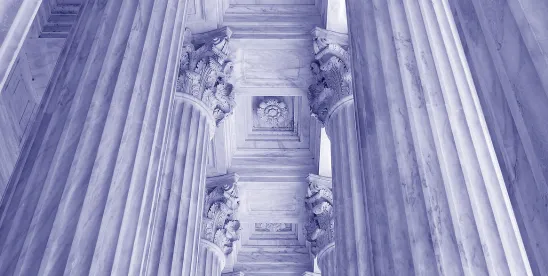The Supreme Court started the day with 14 decisions yet to deliver and only reduced the number by two—neither of them the Trump immunity case nor the Loper case concerning the future of the agency deference doctrine of Chevron.
There will, however, be decisions issuing both tomorrow and Friday, and perhaps an extension of the term for a day or two next week.
As for today’s activity, we start with Murthy v. Missouri, a 6–3 decision. In what might interest Court observers who have suggested cracks in what I’ve long said is an overhyped view of a unified conservative front, Justice Barrett wrote the majority opinion and was joined by two other “conservatives,” the Chief Justice and Justice Kavanaugh, along with the three liberals. The increasingly testy Justice Alito was joined by Justices Thomas and Gorsuch in dissent. The readers of this blog are most certainly aware of the controversy concerning the political and health effects of false or misleading information posted on social media platforms. Under their long-standing content-moderation policies, the platforms have acted to suppress certain categories of speech judged to be false or misleading.
In 2020, with the outbreak of COVID-19, the platforms announced that they would enforce these policies against users who posted such information concerning the pandemic. The same was done regarding fakes and misinformation of a political nature. During that time, various federal officials regularly spoke with the platforms about both pandemic- and election-related misinformation. White House officials, the Surgeon General, and the Centers for Disease Control and Prevention requested that the platforms do more to address vaccine misinformation. Similarly, the Federal Bureau of Investigation and the Cybersecurity & Infrastructure Security Agency communicated with the platforms about election-related misinformation with respect to the 2020 U.S. presidential campaign and the 2022 midterms. The respondents are two states and five individual social media users who sued dozens of executive branch officials and agencies, alleging that the government pressured the platforms to censor their speech in violation of the First Amendment. The U.S. Court of Appeals for the Fifth Circuit held both that these parties had Article III standing to seek injunctive relief and that the government’s coercive pressure and “encouragement” leading to media decisions transformed the matter into one of state action.
Continuing something of a trend of reversals of the Fifth Circuit, the Supreme Court concluded that neither the individual states nor the private plaintiffs had Article III “case or controversy” standing to obtain injunctive relief. Noting that these parties’ theories of standing depended on what the platforms might do in the future, they nevertheless did not seek to enjoin the platforms from restricting any posts or actions. Instead, they sought to prevent government agencies and officials from restricting future speech. Ultimately, the respondents were unable to show a substantial and imminent risk that at least one platform would restrict the speech of at least one plaintiff in response to the actions of at least one government defendant.
On the record before it, the Court held that it was error to conflate hypothetical future actions by the platforms with the actions of the government. The “platforms had independent incentives to moderate content and often exercised their own judgment. To be sure . . . the Government defendants played a role in at least some of the platforms’ moderation choices. But the Fifth Circuit, by attributing every platform decision at least in part to the defendants, glossed over the complexities in the evidence.” Moreover, the Fifth Circuit erred in viewing the parties and the platforms as an integrated whole. Instead, the challengers need to show attributable injury, connecting each platform with each defendant and their specific communications. In short, they can’t “point to any specific instance of content moderation that caused them identifiable harm.” Justice Alito and the other dissenters, calling this “one of the most important free speech cases to reach this Court in years,” asserted that a scrupulous review of the voluminous record in the case was sufficient to document an actionable suppression of free speech.
As was the case with the Court’s recent standing-based decision in the case of criminally convicted persons’ possession of firearms, there is something of a role reversal as to popular expectations concerning standing, with liberals being quite conservative and conservatives the opposite.
The second case decided today, Snyder v. United States, concerned the federal bribery law, 18 U. S. C. §201, which bans two types of unlawful payments to public officials—bribes and gratuities. “Bribes” are advance payments made to influence later official acts. “Gratuities” are essentially “tips” given to reward an official act that already has occurred. Bribes traditionally, and in the law itself, are the more severe, treated as inherently corrupt and unlawful. Gratuities are more nuanced, and some forms of them are not even prohibited. In 1984, Congress and the President extended the gratuities provision of Section 201 to most state and local officials. 18 U. S. C. §666. However, two years later, Congress cut back on Section 666 to avoid the law’s “possible application to acceptable commercial and business practices.” The issue before the Supreme Court was whether the amended federal law makes it a crime for state and local officials to accept gratuities as tokens of appreciation for their past official acts. The answer is “no.” While Section 666 proscribes bribes to state and local officials, it does not criminalize gratuities for past acts. The six Court “conservatives,” led by Justice Kavanaugh, held that six factors taken together—text, statutory history, statutory structure, statutory punishments, federalism, and fair notice—compelled the conclusion that Section 666 is a bribery statute and not a gratuities statute.
This also was a 6–3 decision, with Justice Jackson, joined by Justices Sotomayor and Kagan, arguing strictly from text, dissenting. These “law and order” liberals would seem to have a point. I respectfully suggest that Justice Gorsuch, concurring separately, has a better one, applying the “rule of lenity” to the application of the word “corruptly” as to a statute, the reading of which would leave “any fair reader . . . with a reasonable doubt about whether it covers the defendant’s charged conduct.”
Until tomorrow and Friday. . . .




 />i
/>i
